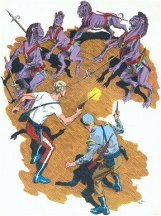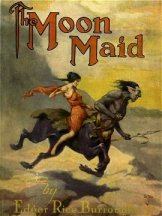ERBzine 1492: Lunar Lost Worlds (original) (raw)
In my previous discussion of the Moon's inner world, Va-Nah, I talked about the �physics� that might shape this fictional world, the same �physics� that shaped Pellucidar, and of how the two inner worlds are similar and different.
In this discussion, I wish to explore the flora and fauna of this strange twin to Pellucidar, and perhaps reconstruct the hidden history of life and civilization here.
Plant Life on the Moon
In marked contrast to the animal life, plant life on the Moon is both diverse and highly adapted. There are, for instance, tough hardy plants which are able to exist on the surface in an atmosphere too thin to support life, and which sprout and grow to hundreds of feet during the short sidereal day of 14 terrestrial days. Their ability to survive the savage extremes of temperatures is nothing short of remarkable.
On the inside, there is a wild diversity of plant life, including grasses, bushes, shrubs, fleshy trees, as well as plants producing large quantities of edible berries, fruit and nuts. There are also edible roots. Plants grow thickly, organizing into grasslands and dense forests. There are even flowering plants. The plant kingdom approaches the diversity and sophistication of Earth. In short, the lushness and diversity of the plant kingdom stands in marked contrast to the threadbare wretches that make up the remaining animal fauna. This remains one of the major paradoxes of the Moon.
There are likely two strong points of departure between Earth plants and Lunar plants. Lunar plants do not use chlorophyll and are not green. Based on this, they do not appear to be (on the interior at least) employing photosynthesis. We believe that they are actually deriving their energy from collecting and absorbing static energy and are engaged in electrosynthesis. However, that aside, their metabolic processes, growth patterns and life cycles simply seem to be the same as those on Earth.
The other strong point of departure, although little is made of it, is that due to lesser lunar gravity, far less structural strength is required to support plants. Therefore, they tend to be fleshy rather than woody. Lunar trees are not particularly strong and do not make good building materials nor effective bows or arrows, although they can make a serviceable spear.
Due to the lack of seasonal or diurnal variation, plants are essentially growth opportunists, whose progress is determined by local variations in moisture.
Critters on the Moon
"Silly looking beggar," remarked Jay. "And devilish unearthly."
"I don't know about that," I returned. "He (the snake) possessed nothing visible to us that we are not familiar with on Earth. Possibly he was assembled after a slightly different plan from any Earth creature; but aside from that, he is familiar to us, even to his amphibious habits. And these flying toads too, what of them? I see nothing particularly remarkable about them. We have just as strange forms on Earth, though nothing precisely like these." (Chapter Three)
In the Moon's interior, only five creatures are described, and they appear to constitute literally the whole of the major animal species. These consist of three reptiles and two mammals:
- A flying toad;
- A four legged snake;
- The Tor-Ho a lynx or cougar sized catlike reptilian predator;
- Va Ga, a quadruped mammalian species with human faces and intelligence;
- Humans. Is this the whole of it? Just about.
There is a hint that there might be animal or insect life on the surface of the moon, but it is no more than an unverified suggestion.
Julian mentions insects or insect life, but doesn't say much more about them. In particular, there are some notable absences. There is no mention of pollinating insects like bees, although there are flowers. There is also no mention of colonial insects like ants or termites, or swarming insects like locusts, nor of primeval �large� insects, nor of eating insects for food by either the meat starved Va-Gas or Humans. At best, what we can infer of the insect life of Va-Nah is that it is small, unobtrusive and not terribly important.
He also makes references to other reptiles occasionally, but none of these are described or given much detail. From the lack of attention, we can only assume that any other reptiles are much smaller and less common than the toad and the snake. These other unidentified reptiles are also noted to have poisonous flesh.
Both the flying toad and the four legged snake are frequently referred to and occasionally seen. The predator, the Tor-ho is much feared but seldom encountered, its diet, we are told, consists primarily of the toad and snake (although it seems quite willing to dine on Human and Va-Gas), it too is poisonous. None of these reptilian creatures is terribly large. One would think at one sixth gravity, that we might see creatures so colossal that elephants and dinosaurs would be dwarfed.
The only truly dominant and common species seen in large numbers or in large sizes are the Va Ga and the Humans. They have the distinction of being different from all of the other named or referenced species in being mammals, and appear to be vastly more advanced than the reptiles they share the world with.
The sheer volume and variety of plants, and the ready availability of water and different sorts of habitats, from forests to jungles, plains, valleys, mountainsides, rivers lakes and oceans, that there would be a vast plethora of creatures, and some quite gigantic creatures.
In fact, there is a sophisticated and complex diversity of plant species, with a wide variety of plants, trees, grasses, shrubs, bushes, fruits, flowers and vegetables, all of which are suggestive of a complex and fully developed ecology. And yet, there are practically no animals.
We should expect to see similar species, but instead, we go from flying toads, to snakes, to reptile-cats, to humans to strange quadrupeds. There are no related species or intermediate species, like apes and monkeys to humans, lions to tigers, dolphins to whales, foxes to wolves, cows to horses. There are not even distantly related, but still obviously kin species like rabbits to dear or dogs to cats. The very few animals that exist seem widely separated and almost completely unrelated to each other, apart from being broadly reptilian or mammalian.
What's going on?
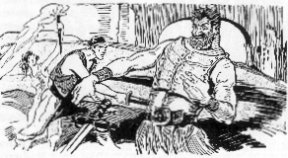
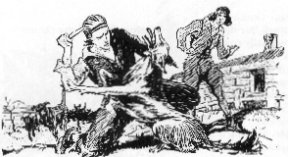
Illustrations from the original Argosy magazine appearance in 1925
The Va-Nah Mass Extinction
In fact, there is evidence of other species having existed on the moon.
"The furniture, though of peculiar design and elaborately carved with strange figures of unearthly beasts and reptiles...." (Chapter 9)
Obviously, these are antiques dating back to the days when �unearthly beasts and reptiles� now extinct still existed or were only recently lost. Further, there appear to be oral traditions of previous forms of life:
"There is no animal in that part of the interior lunar world with which I am familiar, that they may eat with safety. The flying toad and the walking snake and the other reptilia are poisonous, and they dare not eat them. The time had been, I later learned, possibly, however, ages before, when many other animals roamed the surface of the inner Moon, but all had become extinct, except our captors and another creature...." (Chapter Three)
Mass extinctions are common in both our world and Burroughs. Our world has experienced at least six mass extinctions, including the Permian and Mezosoic extinctions where something like 90% of principal species died off. Entire lines of creatures, from Trilobites and mammal-like reptiles, to Dinosaurs and Pterosaurs vanished in a flash.
Barsoom in its desert state has clearly undergone a mass extinction. The formerly rich and diverse flora and fauna are now reduced to a handful of biological islands, like Kamtol, Valley Dor, the Toonolian Marshes, etc., and vast empty lands occupied only by hardy mosses and hardier desert species.
But the lunar mass extinction takes the cake, with literally only a tiny handful of mostly small indigenous species out of uncounted hundreds surviving. The scale of the extinction is even more remarkable considering the survival of such a wide range of plant life.
While it is never specifically acknowledged, the clear implication is that all of the other species extant were hunted to extinction and devoured by the ravenous Va-Gas and perhaps the Human populations.
While it is tempting, within the context of the Moon Maid, to blame the rapacious Va-Gas only, the evidence of the carved furniture suggests that other animal life persisted in reasonable profusion at least to the period of human civilization. Which, in turn implies that humans may have had something to do with mass extinction.
So, in addition to the Va-Gas hunting, we might also consider malthusian overpopulation by both Va-Gas and Humans, as well as pollution, habitat destruction, disruption of migration routes and mating areas and other activities of civilization which have tended to push species to extinction.
Certainly by the time of Julian we have a grim ecology peopled only by a few relict reptiles, and by two apex species who have been reduced to devouring each other and themselves.
Reptiles, the Original Ecology?
One of the puzzles of Va-nah is that setting aside humans and va-gas, all of the other species remaining appear to be fairly primitive reptiles. A serpent which retains four small legs is hardly on the cutting edge of design.
While it is impossible to draw analogies of complexity from terrestrial to reptilian forms, one can still make some general inferences. The forms that we see, with the possible exception of the Tor-Ho, are essentially �spawlers�, their skeletons are not engineered to support their weight.
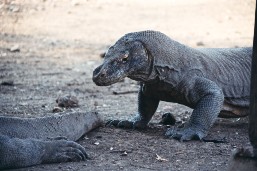 Generally, in vertebrate evolution, higher reptiles and mammals have their limbs placed directly beneath their bodies, so that they can stand easily with little or no effort. The work of defying gravity is done not by muscles, but by the bones of the legs, allowing muscles to focus on propulsion. For this reason, sprawlers on land require far more energy to move around, and move less efficiently and less quickly, which puts an upper size limit on them. Komodo Dragons and Crocodiles are as big as you get with sprawlers, and in the case of Crocodiles, they are semi-aquatic.
Generally, in vertebrate evolution, higher reptiles and mammals have their limbs placed directly beneath their bodies, so that they can stand easily with little or no effort. The work of defying gravity is done not by muscles, but by the bones of the legs, allowing muscles to focus on propulsion. For this reason, sprawlers on land require far more energy to move around, and move less efficiently and less quickly, which puts an upper size limit on them. Komodo Dragons and Crocodiles are as big as you get with sprawlers, and in the case of Crocodiles, they are semi-aquatic.
Because sprawlers skeletons are not engineered efficiently, we usually see other primitive or less effective anatomical features, such as cold bloodedness, inefficient lungs, tiny brains, poor neural systems, inefficient circulatory systems. The general rule of thumb is that if a creature has not been able to manage something as urgent as skeletal efficiency, it's probably not doing great guns anywhere else.
And in fact, this seems to be the case. Even the Tor Ho, the reptilian equivalent of a lynx, is referred to as being cold-blooded, and its relentlessness in the face of damage suggests that it wasn't a very smart creature. There is no indication of its stance, but the fact that it is an �ambush� predator suggests that it is not terribly good at running around. At heart, it's not terribly sophisticated, it's just a mean lizard.
But is this representative of the Moon's previous fauna? The lunar ecology is in the aftermath of mass extinctions, and these forms are merely the survivors of a panoply of more advanced, bigger and tougher forms.
It is indeed possible that there were more advanced reptiles and animals. But it also seems clear that these other reptiles, whatever their advantages, were no match for the Va-Gas or the Humans. Accordingly, we must infer that they were relatively delicate species in comparison to the dominant mammals, eventually pushed to extinction.
Indeed, a flying toad appears to be a fairly advanced and sophisticated creature. Although undoubtedly a cold blooded reptile, the reduced lunar gravity ensured that even its primitive metabolism had the energy for powered flight. The Tor-Ho also appears to be relatively sophisticated, and likely a respectable predator in pre-mass extinction days.
In short, while the surviving reptiles seem primitive, slow and stupid by our standards, it is likely that they were effectively state of the art for their ecology, prior to the humans and va-gas. In short, we can reasonably assume that the whole of the ecology was operating on a rough level of sophistication.
Of course, we're just guessing. In our world, crude lizards, snakes and turtles eke out an existence among a variety of high powered mammals, and the crocodile manages to be an apex predator of swamps and rivers, pulling down far more evolved mammals. We can't tell for sure.
But the evidence for any more sophisticated ecology, or sophisticated fauna, is pretty thin. In fact, there are only three possible hints that the ecology might have had more sophisticated animals: (1) The plant ecology is highly complex; (2) Humans and/or Va-Gas had to come from somewhere; and (3) The carved furniture referred to �reptiles and unearthly beasts�, suggesting non-reptilians. Frankly, that's just thin.
On the other hand, the issue may be decided by the flying toads. The air is a competitive niche. If there had been effective warm blooded creatures around, pterosaurs, bats, birds or some equivalent, it is likely that they would have shoved the flying toads out of their niches and into extinction. I can't see the flying toads occupying their niche if there was anything else around that was substantially more competitive. Crocodiles, when they could not compete with fleet wolves, tigers and lions found safety in the water. There's no safe refuge in the air.
The survivors of the mass-extinction, by and large, are a pretty glum and retiring bunch. It is clear that their survival was due not to any special abilities or adaptations, nor to any lack thereof, but simply to having poisonous flesh.
Setting that aside, we can only infer that they were neither more primitive nor more sophisticated than their extinct cousins.
The Poison Game of Survivors
There is some additional indirect evidence for this. Most of the lunar fauna that we see, the serpent, the toad, and the cat creature are poisonous. Now, it's possible that their poisonous nature is simply the result of biological differences between their flesh and the flesh of the mammals. In which case, its clear that the two mammals are not indigenous to the ecology. Obviously, if you can't eat the home grown dishes, you�re not from the neighborhood.
The implication is pretty clear in the Moon Maid that this catastrophic extinction was caused by the Va-Ga or Humans or both literally wiping out every other species. This seems to suggest that the other species were edible, or at least, more edible. If the other species were generally inedible, then we would have expected more of them to have survived.
Or it may have been that the poison was a defense mechanism. Poison is a relatively complex strategy, not least because it may not be terribly effective for the individual creature. Particularly if your poison is in your flesh. You can't reproduce if you're being vomited up by a dying or horribly sick predator. Maybe the next of your species won't be eaten by that predator, but it hasn't done you much good.
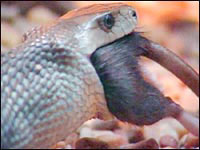 Sure, you're thinking to yourself, �Get bit by a black mamba, and see how effective that is!� But the thing is, that in the two or five or ten or fifteen or thirty seconds it takes for the Mamba venom to paralyse and disable, you've got time to kill that Mamba dead. Predators can be blindingly fast, particularly when hurt, and they are well equipped to kill. This is why most poisonous creatures tend not to go looking for trouble.
Sure, you're thinking to yourself, �Get bit by a black mamba, and see how effective that is!� But the thing is, that in the two or five or ten or fifteen or thirty seconds it takes for the Mamba venom to paralyse and disable, you've got time to kill that Mamba dead. Predators can be blindingly fast, particularly when hurt, and they are well equipped to kill. This is why most poisonous creatures tend not to go looking for trouble.
Insects of course, wasps, spiders, etc., are far more proficient with poison attacks. But then again, they deliver comparatively huge doses of poison, and their designated victims are small enough that the poison works effectively instantaneously, and their biologies are rude enough that the cruder options of tooth and claw aren't necessarily effective. Your typical insect is armoured with chitin, barely has a circulatory or respiratory system and may survive (for a while) losing its head or major limbs. Poison is the best option for wasps. For bigger creatures, it's a different story.
And you might be thinking �Well, a really effective poison could kill instantly.� The trouble is that most of the time, it takes a while to evolve a really effective poison. Consequently, your forbears with their less effective poison are dying right and left. It makes about as much sense as evolving flight by throwing babies off a cliff.
The simpler trend for vertebrate evolution is to get bigger, to get faster, to develop claws, teeth, horns, you name it. Creatures that evolve poison as weapons of offence or defense have pretty much been backed into a corner in evolutionary terms. You're a snake? Well, talons and claws are right out, aren�t they. Horns and armour are locked off. You can't deliver much of a bite. What the hell is left?
So, if we've got poisonous creatures dominating the remnant lunar ecology, that tends to imply that at some point in their evolutionary history, their backs were up against the wall as a result of creatures better with tooth and claw. The existence of poison creatures points the way to a more robust and diverse ecology, and more robust and diverse creatures, most of which seems not to be around any more.
By robust and diverse, of course, I don't necessarily mean evolutionarily sophisticated. I just mean that whatever was around in terms of predators, had bigger claws, bigger teeth, faster reflexes, and were just generally bigger and meaner.
Could the poison creatures have eventually used their asset to dominate the ecology? Unlikely, they've got too many apparent structural handicaps, and frankly, they haven't done especially well dealing with humans. The simple fact that they evolved poison as a defense suggests that they were outgunned. It's not likely that they'd be able to handle really tough little bastards like Rats. What they've got, at best, is a single advantage that allowed them to survive the big mass extinctions.
There were almost certainly more robust and diverse forms, but then again, its not likely that the old ecology was filled with creatures substantially more complex or advanced. Otherwise, Julian would be facing the equivalent of rats, rabbits, weasels and raccoons.... Tough hardy general purpose opportunists, and quite possibly poisonous. Instead, he's facing what are in Earth terms, the low power �also rans� who were merely good at finding a place to hide out.
So what was the pre-extinction Lunar Ecology like? Probably lots of sprawlers. The low lunar gravity would make it comparatively easy for sprawlers to reach large sizes, and would delay the emergence of �straight legged� types. Probably a lot of lizard type creatures, turtles, snakes, frogs, etc. Think of Earth during the early Permian period.
Easy prey for the emergence of humans and va gos.
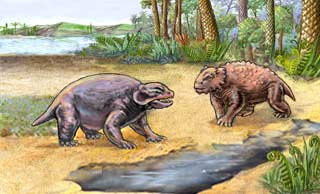
The Human Puzzle
In the city of Laythe, a wise man begins a conversation with Julian, intrigued by his claim to be from another world.
"There are fragmentary, extremely fragmentary, legends handed down from extreme antiquity which suggest that our remote ancestors had some knowledge concerning the other worlds of which you speak," the said, "but these have always been considered the veriest of myths. Can it be possible that after all they are based upon truth."
In other words, there are hints in the legends of worlds outside of Va-Nah. That Va-Nah might not be the sum total of the Universe.
"If what you tell me is the truth, for our legends bear out the theory that Va-Nah is located in the center of an enormous globe and that our earliest progenitors lived upon the outer surface of this globe, being forced at last, by some condition which the legends do not even suggest, to find their way into this inner world."
Here our native of Laythe begins to speculate. The only thing the legend says clearly is that they're living inside of an enormous globe. He isn't claiming that the legends say that his ancestors lived on the surface of the moon, this is merely the conclusion he draws. At best, the legends seem to suggest that the early humans lived on the surface of a world, not necessarily this one. Also, note the admission that the legends are silent as to how or why humans wound up inside the moon. They have no clue.
"If you reached us from another world, is it then so difficult to believe that those who preceded us reached Va-nah from the outer crust of this Moon?"
A wild eyed speculation which, alchemically transforms into:
"It is almost a historic certainty,� he continued, �that our ancestors possessed great ships which navigated the air. As you entered Vah-nah by means of a similar conveyance may not they have done likewise."
Except of course, that for all his �historic certainty�, there are not even legends of his ancestors entering Va-Nah, nor of how or why they did so. Thus, the wise man of Va-nah proves himself fully human by engaging in that time honoured sport, jumping to conclusions.
The thing, of course, is that humans are pretty much inconsistent with our picture so far of the lunar ecology. If indeed the surviving reptiles are representative of a Permian era level of development, and they seem to be, then we are approximately two hundred million years out of place. We don't fit. And for that matter, neither do the Va-gas.
So? What else is new? Humans stick out like a sore thumb on Barsoom, on Thuria, on Poloda, on Venus and even Jupiter. Earth is about the only place we can definitely say that humans fit in.
Obviously, then humans are from Earth. And its likely that humans are only recent immigrants to the moon from Earth.
For one thing, lunar humans are still skeletally designed for Earth gravity. Look at it this way, take your average 150 lb to 200 lb human, scale their weight up instantly to 900 to 1200 lbs, and watch their legs snap like breadsticks, watch them struggle to breath, watch their lungs fill with fluids. A lunar creature evolved or fully adapted for lunar gravity simply won't survive.
However, a terrestrial evolved creature which has not been on the moon long enough to lose its heavy gravity adaptations would survive the return to Earth. It might not be happy, but eventually, its muscles would re-adapt, and succeeding generations would dance like they'd never been away.
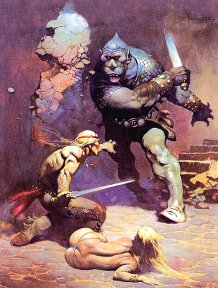 The fact that the Kalkars can survive on Earth, much less conquer it, suggests that they and other lunar humans are from Earth originally, and have not been on the moon long enough for the heavy gravity adaptations to be lost. There is some indication, however, that the heavy gravity adaptations were being diluted. The great size of some Kalkars is suggestive.
The fact that the Kalkars can survive on Earth, much less conquer it, suggests that they and other lunar humans are from Earth originally, and have not been on the moon long enough for the heavy gravity adaptations to be lost. There is some indication, however, that the heavy gravity adaptations were being diluted. The great size of some Kalkars is suggestive.
The fact that lunar humans and terrestrial humans are both sexually and reproductively compatible is the final cinch. In the Moon Maid, moon people are sexually attractive and beautiful to terrestrial men. In fact, the moon maid herself is attracted to the comely earth man. Clearly standards of beauty are just about identical, as are romance and courtship.
Further, as we see in "Red Hawk," the Kalkars are genetically and reproductively compatible with humans to the extent that after a few hundred years, they are almost a completely hybridized race.
In short, by every possible yardstick the lunar humans are identical to earth humans.
It is impossible to see the lunar humans as independently evolved, although Julian at one point seems to think so. Even were humans to independently evolve, they certainly would not evolve out of such a primitive ecology, would not evolve to such terrestrial standards of beauty, would not evolve adapted to earth life and earth gravity, and would not evolve to reproduce with us..
The only conclusion is that they are a derivative population, as, probably, are most of the other human populations in the solar system.
Of course, this doesn't explain how humans were able to arrive. Clearly, if they didn't evolve on the Moon. They must have come from Earth. But if so, how? The lunar civilization has no coherent record or legends of origins somewhere else. Their journey to Va-nah obviously preceded their civilization, and preceded the discovery of writing. Otherwise there would have been written documents carved in stone or impressed on clay tablets or handed down to be copied and recopied. The Va-nah peoples do not even really believe that outer space or other worlds exist.
Although they have a high civilization, or at least, had a high technological civilization, it appears that this high technology was indigenous and not external. In short, there is no indication that their race achieved space travel and settled the moon. Another possibility is that aliens transported them, but again, the presence of such aliens is not even hinted.
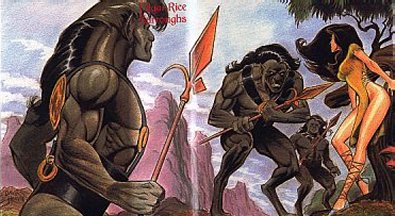
The Problem of the Va Ga
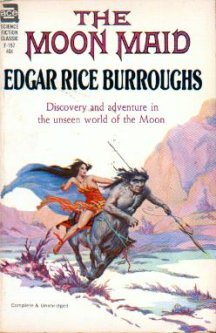 And they are a big problem. Taxonomically, they are like no other creatures known in the solar system. The best we can come up with is that they're sort of like a big hoofed bear hominid.
And they are a big problem. Taxonomically, they are like no other creatures known in the solar system. The best we can come up with is that they're sort of like a big hoofed bear hominid.
What can we determine about them? Well, they have human faces, human or near human intelligence, a history of tool use, a mammalian four limbed body plan. On those particular criteria, we might ascribe Va Ga to the human species. However, clearly they are not human and their quadrupedalism takes them entirely out of the human line. They aren't even knuckle walkers like apes.
On the other hand, their social and reproductive behaviour, including herds and bull/harem groupings are more suggestive of hoofed herbivore mammals. Their reduction of digits is also a sign of herbivore evolution.
They are not bipeds, though capable of bipedal stances and movement. In this respect, they seem to be like bears. And like bears, they are omnivorous. But clearly, they are not ursines. They display a range of skeletal, anatomical and behavioural features common to Earth mammals.
But they don't seem to fit comfortably in any Earth taxonomy. Like humans on the moon, and unlike the green men on Barsoom, they seem to stick out like a sore thumb in the ecology. Moreover, they appear completely foreign to the ecology of Barsoom, which is characterized by multi-legged forms, and alien to Venus.
In short, there is no possible way they can be anything but Earth derived, but they don't seem to have any close relatives in Earth terms.
Given that their closest relatives in the lunar ecology are humans, the temptation is to describe them as a radically adapted offshoot of the human line. This is, in fact, an idea that Burroughs, through both Julian and Orthis are playing with.
This is not out of the question. Human/Mammal adaptations might be so superior to those of the existing lunar fauna that one could see human variants diversifying radically into any number of ecological niches.
On the other hand, it's clear from the situation of the U-gas and Kalkars they have not been on the moon long enough to speciate. There is no way that the Va Ga can derive from the current human population of the moon, there simply is not enough time. The sort of time necessary for these radical adaptations would also result in the loss of the ability to survive on Earth.
It is possible, and perhaps most likely, that the Va Ga may represent a previous evolved human population. In which case, human colonization of the moon's interior comes in two stages.
The first wave is composed of primitive humans, low tech hunter gatherers, perhaps an original cult of moon-worshippers, who rapidly adapt or evolve, displacing the far less effective local life to become the apex creatures in various niches.
Of course, if this is so, then we are doubly confused. Since not only is it a mystery as to how the Va-gas, or the human ancestors of the Va-gas arrived on the Moon. It's also a mystery as to how and why they evolved to their present form.
Astral Teleportation Revisited
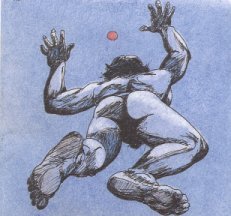
Actually, I first developed this idea in the article �Are Martians Human� and would recommend you go and read that. But for the short primer, allow me to offer this:
The most likely means by which humans came to the moon is the Astral Teleportation. The phenomenon of Astral Teleportation, the instantaneous transfer of a person from one world to another, and their materialization in a new and whole body, has been experienced repeatedly by John Carter, Ulysses Paxton, Betty Callwelland Tangor in other adventures.
John Carter might have been a fluke, a star crossing freak. But the fact that at least three other persons have accomplished the journey suggests that it is a rare but real inherent human potential in the Burroughs universe. If these people have managed the journey in our age, then we must assume that in the vast distances of the past, other people, perhaps hundreds, perhaps even thousands or tens of thousands, must have accomplished the same trip. In fact, it may once have been far more common, in ages of mysticism and magic than in our rational age.
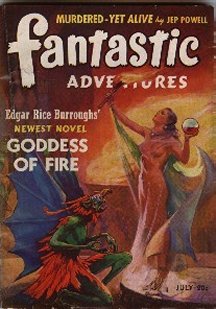 Indeed, assuming that this sort of Astral Teleportation takes place, the moon, as the most prominent object in the sky, would be one of the most likely targets. . . particularly for primitive cultures that worshipped the Moon. John Carter and Ulysses Paxton travelled to Barsoom, in part, because in their moments of transfiguration, that was the target they selected and willed themselves too. For primitive peoples, the moon would be the biggest and most obvious target.
Indeed, assuming that this sort of Astral Teleportation takes place, the moon, as the most prominent object in the sky, would be one of the most likely targets. . . particularly for primitive cultures that worshipped the Moon. John Carter and Ulysses Paxton travelled to Barsoom, in part, because in their moments of transfiguration, that was the target they selected and willed themselves too. For primitive peoples, the moon would be the biggest and most obvious target.
But the thing with Astral Teleportation is that the man or woman who arrives is not precisely, or perhaps in not precisely the same body that they left Earth in. Both Tangor and Ulysses Paxton receive horrific injuries on Earth. Yet their bodies on other worlds are miraculously restored with all faculties intact.
Some features are carried over. The ethnic make up, skin colour, genotypical features, even Earth born strength and reflexes and even presumably hair and hair style. But if Tangor materializes in one piece and Paxton has his legs back, clearly some adaptation, has gone on. This adaptation may be more extensive and subtle than we realize.
John Carter, for instance, arrives on Mars able to breathe, not bothered by the temperature fluctuations or lack of humidity, able to eat local food, and untroubled by local diseases. There doesn't seem to be any good reason why he simply didn't choke out his last few days as a frozen, fever wracked, starving asthmatic gasping for breath.
Instead, he takes to an alien atmosphere, alien chemicals in the water and food, alien biology, alien dust and microbes in the air, all like a duck to water. And he discovers that he's cross fertile with a woman who lays eggs? So, it seems that there is a profound and subtle adaptation process that is involved in transliterating humans from one world to another.
There may simply be a range of adaptation, so that some visitors to Mars have brief unadapted lives, choking to death on alien pollen, some wind up like John Carter, and some wind up radically mutated.
I have argued that anomalies in human populations on other worlds, like the egg laying of Martian females, might be the result of this �adaptation�, incorporating local biology into their systems. I've even argued that other intelligent species, like the green men of Barsoom, might be originally human, but so mutated or transformed by the incorporation of local biology that they are no longer human and no longer capable of Astral Teleportation (which means no Green Men on the moon and no Va Ga on Mars).
It seems likely that as part of the adaptation to the alien world, there is sometimes the incorporation to varying degrees of alien genetic material in some way. It seems more viable to survive by incorporating alien traits, than to try to randomly develop new traits independently. The early or original human populations, on a virgin world, may have found it difficult not to mutate. Or it's even possible that the early human travellers arrived mutated or with the seeds of mutation.
So, based on this reasoning, it is entirely possible that the transfer of initial human populations to the moon carried inherent mutating effects. Humans did not simply arrive on the moon. But they arrived with varying degrees of adaptation, and some arrived mutated. At least some of the mutated humans may have been Va-Gas or the predecessors of Va-Gas. There may well have been a series of other adapted human types, in addition to the Va Ga.
The mammalian biology is so much more efficient than the local biologies, that actual hybrids would simply not be able to compete with their less adapted brethren. On Barsoom, the animal biology is robust and aggressive, hence a biological human/local hybrid like the Green Man would thrive. On the moon, a human/local biology hybrid would be a sitting duck for the more closely human types. The local animal life was so comparatively weak that a true hybrid would always be weaker than the human or mutated human stock. Hence the clearly terrestrial nature of the Va Ga.
Nevertheless, the planet was ripe with relatively primitive and weak species occupying all sorts of niches. Even a mutated human was so far ahead on the evolutionary ladder that he had a fair chance of establishing himself and kicking the original species out of its niche, or even establishing a new niche.
It is likely that there was an adaptive radiation and more speculation than the Va-gas. One might imagine lion-like predators, wandering herbivorous giants and even mer-men or seal men. The lunar ecology is probably a simplified realm much earlier in evolution, which would limit the ecological niches available.
Ultimately, of course, the Va-gas either succeeded in wiping out their other mutant human competitors, and perhaps a great many other species as well. Or perhaps the Va-gas were the loan survivors of the eventual establishment of a civilization by later appearing true humans.
Finally, allow me to offer one final thought. The profusion and diversity of life on other worlds in the solar system, such as Venus and Mars, and including worlds where normally life of our sort should be completely impossible, such as Jupiter and the Moon, may indicate that Astral-Teleportation is not a singular phenomenon confined to humans.
In our universe, these worlds are all uninhabited and uninhabitable. In Burroughs universe, not only are they inhabited, but they sport earth normal environments tolerable to humans, and while the flora and fauna differ, they are similar to the point of being interchangeably edible. Thus, Julian eats moon food, Carter dines on both Barsoom and Garobus, and Carson feasts on Venus. The only way this seems possible, is if there is some force which has �redefined� these worlds to Earth norms and Earth compatibility.
I would suggest that there is a sort of planetary astral-teleportation which does not simply create a new body for a man or animal out of local elements, but instead, literally recreates the surface of a world to make it hospitable for life.
It might be a Gaean Effect, a broad planetary feature of the world's bio-magnetic aura. From time to time, perhaps in times of worldwide crisis including eminent mass extinction, the collective life force or life forms of Earth can astrally project the planet's life force, or perhaps a clone of the life force, out into space towards another world. Upon contact with the world, the collective life force or life forces mutate to adapt to a new world, while also seeking to adapt it.
It is likely that once that life is established on another world, it has its own bio-magnetic aura that resists further large scale colonization. Instead, the new flora and fauna simply go their own way.
Hence, my suggestion is that not only are humans and va-gas derived from Earth at different times, but so, ultimately, are all of the Moon's life forms.
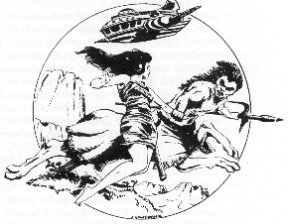
A Reconstructed History of Life on the Moon
Approximately four billion years ago, the Moon and Earth, as well as other planets are formed. The Moon and Earth, and likely other inner planets, form as hollow worlds, with small dwarf singularities in the centre.
The singularity inside the moon attracts a vast heavy atmosphere which also surrounds the moon. Eventually, the singularity goes dormant as a carbon shell crystallizes around it just outside its event horizon.
The moon is at first geologically active with volcanoes, earthquakes and tectonic plate motion. Numerous Hoos open as a result of tectonic activity. Over time, this activity slows down and cools, the moon dies geologically. During this time, it experiences tidal lock with Earth, showing the same face always to Earth.
Approximately two hundred million years ago, at around the time of the Permian extinction, the Gaean life force of Earth projects itself, or a copy or fragment of itself, to the Moon. This causes the transformation of the Moon's inner and outer surfaces and a flowering of life, mostly similar to Permian species. During the early mutation phase, some interior plants are shifted to electrosynthesis and some exterior plants are adapted to the brutal solar conditions.
Life quickly fails on the Moon's surface, although a relic ecology of hardy plants manages to adapt to a crude 28 day cycle and survive. Animals are reduced perhaps to insects, or vanish entirely. The relic life of the surface does not advance. The surface remains inhospitable and uninhabitable.
Life on the inside establishes itself, and establishes its own Gaean bio-magnetic field, thus fending off future Gaean fields from Earth. The interior surface area is only about the size of North America, and large parts of that are taken up by three Oceans. The result, biologically, is a relatively small, backwards bio-continent effectively no larger than South America or Australia, which makes evolution difficult. Further compounding evolution's handicaps, the weather is unchanging without real seasons or day/night cycles, there is no more geological activity, hence no more plate movements with continents or islands joining or rejoining, there are no ice ages, no droughts, no floods. In short, there is no evolutionary or adaptive pressure. Largely shielded on the inside of the world, there is not even radiation to cause mutation.
Over the next two hundred million years, the life inside the moon evolves extremely slowly. Meanwhile, Mars and Venus are colonized by Gaean bio-magnetic fields which radically transform those worlds, a process which in turn, radically transforms the life forms inside the Gaean field. With large new worlds of fifty to two hundred million square mile areas, and with substantial evolutionary pressures from geography, weather, seasons and climate, the Martian and Venerian life evolve and maintain a comparable degree of sophistication with evolving terrestrial life.
During this period, the lunar life makes a few strides, developing powered flight with the flying toads, evolving snakes and predators, and probably evolving a diversity of large carnivorous and animal life forms. The overall level remains primitive, and the life mostly consists of cold blooded sprawlers. But because of lack of competition, the �lizards� are able to grow larger and more diverse than they ever did on Earth. Plants evolve more rapidly, developing fruits and berries to facilitate their reproduction.
At some point, a Gaean bio-magnetic field manages to transform a segment of Jupiter in a way that has some degree of long term stability. Also, other Gaean bio-magnetic fields, either from Earth, or possibly from Mars or Venus, and either clones or fragments, wind up reaching worlds in interstellar space, such as Poloda.
Approximately 100,000 years ago. Humans develop with the faculty of personal astral teleportation. This early ability is imperfect, however, and humans materializing on other worlds, a process they do not truly comprehend, are often imperfect, mutated or crossed with other life.
Pure, mutated and hybrid humans begin to appear on the inner surface of the Moon.
Pure, mutated and hybrid humans begin to appear on other worlds, particularly Mars and Venus.
Hybrid humans fail on the Moon. But mutated species establish themselves, including the Va-Gas. There is an initial round of extinctions as the Va-Gas, other mutant species, and true humans establish themselves.
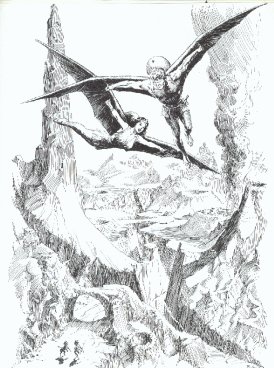
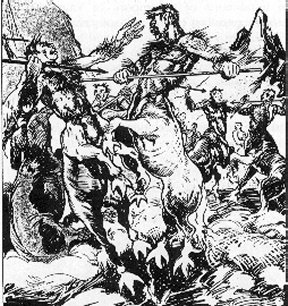
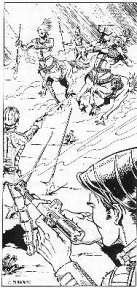
- On Mars hybrid humans and true humans flourish, but mutated humans die off. Meanwhile, on Venus, Hybrid, Mutated and True humans all flourish in different environments.
- Around ten thousand years ago there is a wave of true humans arriving on the Moon. These true humans are from an early civilization or proto-civilization and have mastered the rudiments of agriculture, metallurgy, bows and arrows, urban living and military tactics. Faced with a strange new world, these scattered humans unite with each other and with other true human groups to form the first lunar civilization.
- This civilization quickly dominates or destroys other human and mutant groups and dominates the interior world. Science and technology progress on a trial and error basis, and they master the use of electricity, employing it for transportation, communication and industry. Among the accomplishments are flying ships and railway trains. Their science, however, remains crude and primitive, and they have no clear idea of their place in the universe.
- Accompanied by their rise comes runaway overpopulation and reckless exploitation of resources. There is an ecological crisis, including mass extinctions of almost all other animal life. Widespread starvation ensues, and the survivors turn to cannibalism of each other and the Va-gas, the only surviving mutant species, which returns the favour. There are massive die offs or population reductions of the human population, and the Va-gas, a tougher hardier breed experience a renaissance.
- The civilization re-establishes itself at a smaller population level based in defended or fortified cities. It is now a cannibal society, bent on enslaving and taking the world back from the Va-gas. It has lost much of its technological proficiency, lacking any underlying understanding of the science behind its technology in the first place.
- Over time, dominance over the Va-gas is re-established. However, the civilization remains permanently impoverished, both intellectually and materially. There are large ignorant underclasses, and a more or less permanent economic depression.
- The Kalkar movement begins as a proletarian �know nothing� rebellion. Similar to both Nazism and Communism, the Kalkar movement despises the official elites and preaches their destruction, while at the same time establishing themselves as a secret elite with the trappings of populism. The old ruling class, isolated, inbred and largely incompetent, are no match for the new populist movement and fall, one by one.
- By the time of Julian, there is only a single city left to the aristocrats of the old civilization, and even then, they are unable to put aside their internal squabbles and politics to defend themselves. The Kalkars rule the Moon. This would hardly be much of a prize since they inherit a shattered economy, a deteriorating technology and an ecology laid waste by the most comprehensive mass extinction ever. However, they have obtained the services of an Earthman, Orthis.....
- - The rest, we know....
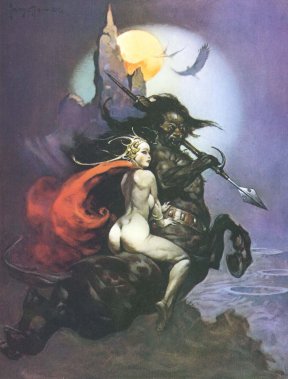
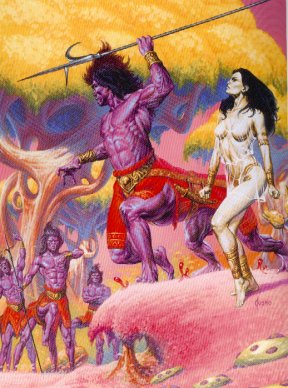
Appendix 1, Plant Life of the Moon
Outer Surface: Closer observation revealed the fact of a weird fungus like vegetation which grew so rapidly that we could clearly discern the phenomena. ....the entire life span of this vegetation is encompassed in a single sidereal month. From the spore it developed in the short period of a trifle over 27 days into a mighty plant that is sometimes hundreds of feet in height. The branches are angular and grotesque, the leaves broad and thick and in the plants which we discerned, the seven primary colours were distinctly represented. As each portion of the moon passed slowly into shadow, the vegetation first drooped, then wilted, then crumbled to the ground, apparently disintegrating almost immediately into a fine dust like powder. (Chapter 1)
Inner Surface: There were forests, too - strange forests, of strange trees, so unearthly in appearance as to suggest the weird phantasmagoria of a dream..... The ground about us was covered with rank vegetation of pale hues - lavenders, violets, pinks and yellows predominating. Pink grasses which became distinctly flesh coloured at maturity grew in abundance, and the stalks of most of the flowering plants were of this same peculiar hue. The flowers themselves were often of highly complex form, of pale shades, of great size and beauty. There were low shrubs that bore a berry like fruit and many of the trees of the forest carried fruit of considerable size and a variety of colours. (Chapter Three)
Lunar vegetation reproduces itself entirely independent of any seasonal restrictions, the frequency and temperature of the rains having seemingly, the greatest influence in the matter. A period of drought and cold rains retards growth and germination, while frequent warm rains have an opposite effect, the result being that you find vegetation of the same variety in all stages of development, growing side by side - blossoms upon one tree, fruit upon another and the dry seed pods upon a third. (Chapter Five)
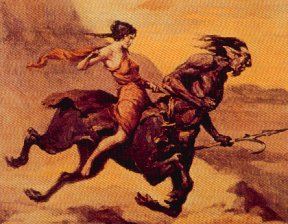
Appendix 2: Critters on the Moon
SURFACE
(On the outer surface of the Moon) Jay and Orthis were positive that they discerned some form of animal life, either insect or reptilian. These I did not see, though I did perceive many of the broad flat leaves which seemed to been partially eaten. (Chapter 1)
RYMPTH
A five foot snake with four frog like legs and a flat head with a single eye in the centre of the forehead. Its legs were very short, and as it moved along the ground it both wriggled like a true snake and scrambled with its four short legs. We watched it to the edge of the river and saw it dive in and disappear beneath the surface. (Chapter Three)
Rympth is the name of the four legged snake of Va-nah, the inner lunar world, and considered the lowest and most disgusting of created things... (Chapter Six)
FLYING TOADS
We already had seen evidences of life of a low order, both reptile and insect, or perhaps it would be better to describe the latter as flying reptiles, as they later proved to be - toad like creatures with the wings of bats, that flitted among the fleshy boughs of the forest, emitting plaintive cries. (Chapter Three)
The flying toads darted from tree to tree about us, uttering their weird and plaintive cries, while upon several occasions, as in the past, we saw four legged snakes such as we had seen upon the day of our landing. Neither the toads nor the snakes bothered us, seeming only to wish to avoid us. (Chapter Three)
TOR-HO
"We know of no other dangerous beast, except the Tor Ho. They are seldom seen." (Chapter Seven)
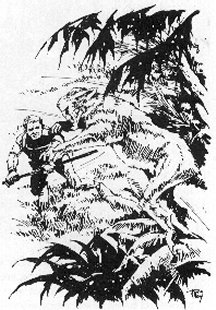 There was always the danger, she told me, of our being attacked by tor-hos. These blood thirsty creatures, while rare, were nevertheless very much to be feared, since not only were they voracious meat eaters and and of such a savage disposition that they attacked nearly everything they saw in wanton ferocity, but even a minor wound inflicted by their fangs or talons often proved fatal, because of the fact that their principal diet was the poisonous flesh of the rympth and flying toad..... It stood between eighteen inches and two feet in height, had long, sharp fangs, four legs and was hairless. (Chapter Seven)
There was always the danger, she told me, of our being attacked by tor-hos. These blood thirsty creatures, while rare, were nevertheless very much to be feared, since not only were they voracious meat eaters and and of such a savage disposition that they attacked nearly everything they saw in wanton ferocity, but even a minor wound inflicted by their fangs or talons often proved fatal, because of the fact that their principal diet was the poisonous flesh of the rympth and flying toad..... It stood between eighteen inches and two feet in height, had long, sharp fangs, four legs and was hairless. (Chapter Seven)
There leaped from the concealment of the bushes a creature about the size of a North American mountain lion, though quite evidently a reptile and probably a tor-ho, as such it proved to be. There was something about the head and face which suggested the cat family to me, yet there was really no resemblance between it and any of the earthly felines It came at me with those terrible curved fangs bared and bristling.... It emitted the most terrifying sounds - I have called them screams.... and yet they were a combination of shrieks and moans. (Chapter Seven)
The creature was covering the ground at tremendous speed.... I did not know of the tremendous vitality of the creature... What appeared to be cold blood was oozing slowly from its wounded face.... Time and time again it charged me... (Chapter Seven)
OTHER REPTILIA
"There is no animal in that part of the interior lunar world with which I am familiar, that they may eat with safety. The flying toad and the walking snake and the other reptilia are poisonous, and they dare not eat them." (Chapter Three)
EXTINCT
"The furniture, though of peculiar design and elaborately carved with strange figures of unearthly beasts and reptiles...." (Chapter 9)
"The time had been, I later learned, possibly, however, ages before, when many other animals roamed the surface of the inner Moon, but all had become extinct, except our captors and another creature...." (Chapter Three)
